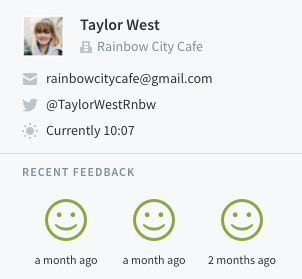How satisfied your customer is can depend on a lot of things: your product, your customer support team, your marketing and advertising, your branding, their interactions in your store, your website, your in-store staff… the list goes on.
Typically, businesses rely on customer satisfaction scores as an indicator of the total happiness of a set of customers – but this is flawed.
That’s not to say customer satisfaction surveys aren’t valuable – they are, hugely valuable. But used incorrectly, they can become a faux guiding light or vanity metric, instead of providing actionable insights.
For example, Fred Reichheld, author of The Ultimate Question: Driving Good Profits and True Growth, reported that businesses that exclusively use customer satisfaction scores have a churn rate of 60-80%, even though they were satisfied or very satisfied in their last CSAT survey. Clearly, satisfaction isn’t great for measuring loyalty either.
So how should you interpret your customer satisfaction score? What can it tell you about your current customer base?
First, businesses must rebase their understanding of what customer satisfaction indicates. They should look towards a more holistic combination of metrics to achieve their true goal: better-understanding satisfaction throughout customer journeys.
When to use customer satisfaction surveys
The most important thing to understand about customer satisfaction surveys is that they aren’t broadly representative or indicative of your entire customer base. Instead, they are better used to pinpoint customer satisfaction at natural pause points throughout your customer journey.
Satisfaction surveys work best when used after interactions with your business – whether that’s an experience with your product, your support team, or marketing material.
How support teams typically use CSAT surveys
In the world of customer support, CSAT surveys are commonly asked after a support conversation is completed, as a ‘rating’ mechanism. This is an example where interaction-based CSAT surveys work well: customers are asked their explicit level of satisfaction with their support experience.
Measuring customer satisfaction at pause points after interactions provides trends as a result of business changes and improvements.
For example, if your team measure CSAT after one week of product usage, and your score falls to 90%, you know there are improvements to be made. Say you act on this feedback and implement a better product onboarding process and your score rises to 95%, you can be confident these changes have directly impacted and improved the customer experience.
This direct feedback loop would be lost if CSAT surveys were based on time intervals instead of interactions.
Customer satisfaction doesn’t result in loyalty
Customer satisfaction surveys can also be misunderstood as an indicator of loyalty.
Neither NPS nor CSAT are an indicator of future loyalty when measured individually. When combined, NPS and CSAT can help identify your loyal advocates and those customers most at risk of churn, and help you take a better direction when communicating with a customer.
Measure satisfaction to understand the whole customer experience
When putting together your customer satisfaction survey process, there are some guidelines that will help you maximize response rates and get a truer picture of customer satisfaction.
How did we do?
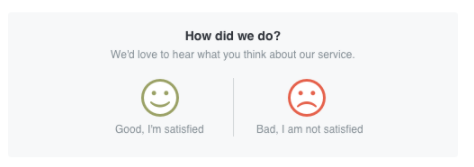
There’s a reason for asking this in a closed, specific way – and that’s because you want to understand their satisfaction with a specific part of their experience.
The shorter the survey, the more responses you’ll likely receive as well – giving you more data and valuable insight.
By asking for their satisfaction with your product, support team, or other interaction, you’re asking the customer to provide their explicit thoughts about their entire experience.
For example, in support interactions this can also cover how easy it was to request support, the quality of your support rep’s responses, and how quickly their request was dealt with.
Allowing only two possible responses – one positive, one negative – means not only does the customer have less to think about, but the data you’ll receive back will be more polarizing and help you spot and prioritize areas that need immediate improvement.
Timing and context is important as well. It needs to be soon enough so the experience is fresh in their mind, but not so long after they’ve forgotten.
At Kayako, we recommend sending customer satisfaction surveys 24 hours after a conversation has been resolved by email – but immediately after for live chat conversations.
Also account for different contexts: if you’re asking for a customer’s satisfaction with your product, it makes sense to ask when they log in; if they’ve called your call center, send the survey by SMS.
Understanding the metrics that matter: what should you do with your customer satisfaction survey results?
After running your survey, you’ll end up with a list of 🙂 and 🙁 responses about a specific interaction they’ve had with your business. Where next?
Segment your scores into positive and negative. Often, you can do this through the customer service software or survey tool you use, but this is how to create a report for exporting customer satisfaction ratings in Kayako.
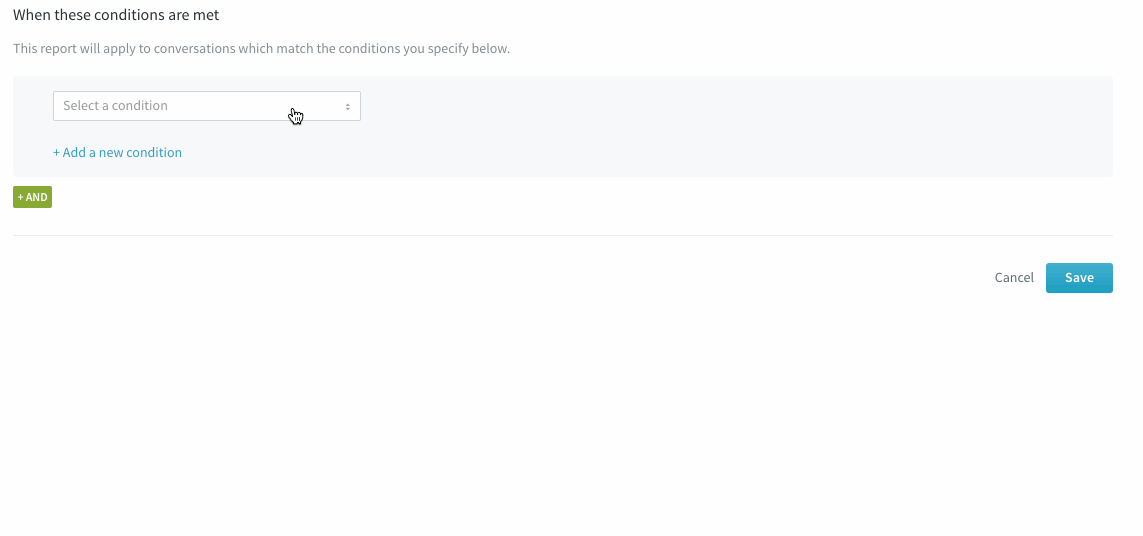
Before diving into an analysis, follow up with customers who’ve left negative responses. This is important because they may be at risk of churning. Often, a simple fix is needed to restore their satisfaction and start fostering loyalty.
Next, it’s time to work out your CSAT score. This is calculated by dividing the total number of “positive” responses by the total number of “negative” responses, then multiplying by 100.
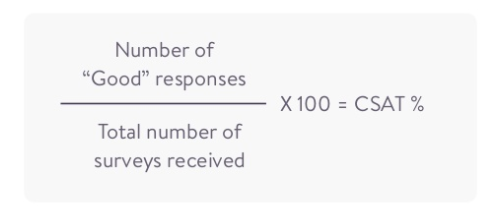
Congratulations! Now that you’ve calculated your customer satisfaction score for a part of your customer’s journey, it makes sense to start tracking CSAT for more points along their journey. The goal is to end up with a graph like this:
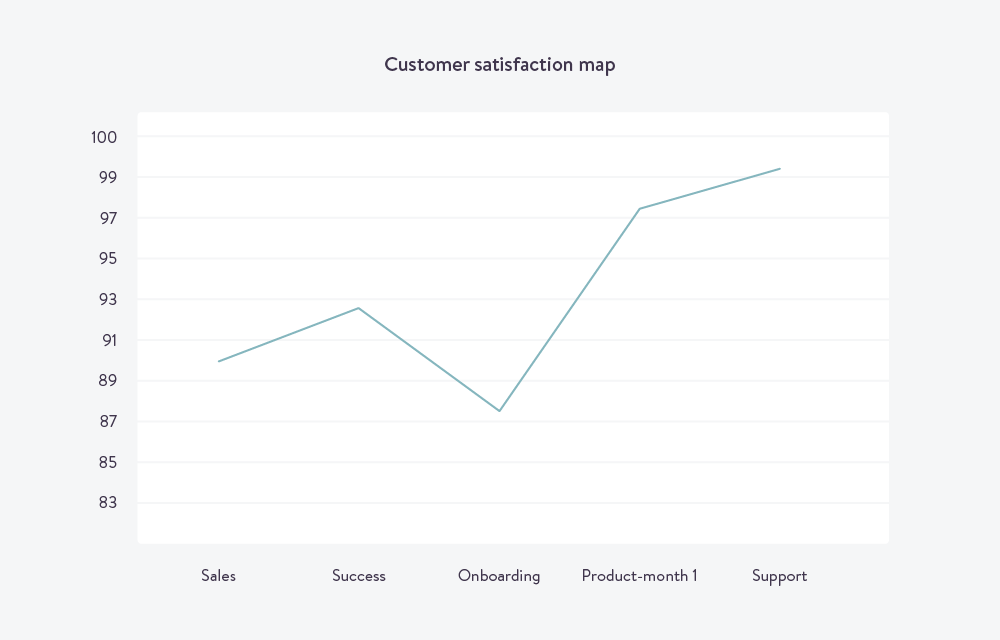
From mapping your customer satisfaction, this will immediately help visualize the areas that need improvement, and identify tactics in successful areas that are working so you can double-down!
You can then start to analyze which teams, channels, product areas, and types of interactions are more successful than others. Identify elements that can be ‘borrowed’ for quick wins, and see where further investment is required.
CSAT scores should also not be taken in isolation. As mentioned earlier, combine CSAT with other metrics like NPS, Customer Effort Score, and other customer service metrics for a more holistic, rounded view of your customer base.
Caring is… sharing CSAT scores across your business
Depending on your business’s goals and objectives, customer satisfaction may be a key metric, or a secondary (or even tertiary) metric for your team. But CSAT scores are much more helpful to other teams than first thought – especially as tactics to improve CSAT often require cross-functional input.
For example, product teams can improve CSAT scores through product development and communication; marketing teams can add value to CSAT by better setting expectations in bottom-of-funnel content; and even finance teams can contribute by making improvements to payment processes.
It’s important to get everyone involved on the same page and set out important areas of focus. This may be a series of quick wins and a few areas which require deeper thought.
At Kayako, our support team send out a bi-weekly roundup and analysis of their CSAT score and specific comments.
“The report analyzes our key trends on support conversation ratings to better understand and shift our focus accordingly. It also reflects on the common trends of conversations with negative ratings, so we can learn and improve.” – Akash Sethi
As mentioned, customer satisfaction scores can also provide a guide to communicating with customers.
For example, knowing a customer is happy with their most recent product interaction would allow a sales executive to approach the conversation differently, than if they knew the customer was unsatisfied.
Making individual customer satisfaction scores available as part of their workflows (by integrating into CRMs, marketing tools, and support tools) makes a customer’s data much more actionable for everyone involved.
In Kayako, we make it simple to view a customer’s satisfaction rating, so you can adapt your support responses accordingly.
Why customer satisfaction is crucial to your business success
Customer satisfaction is more than just a vanity indicator of customer happiness: it provides real, actionable insight that helps departments across your business to improve their customer experience and processes.
CSAT is most valuable when applied both across and throughout your customer journey:
- At an individual level
- Analyzed across various customer segments
- When measuring specific events or interactions
- When mapping across an entire customer journey
In a world where customers demand personal, tailored customer experiences – and where the internet means switching away to a competitor is easier than ever – knowing, and acting upon, levels of customer satisfaction must be a crucial part of your customer feedback process.
